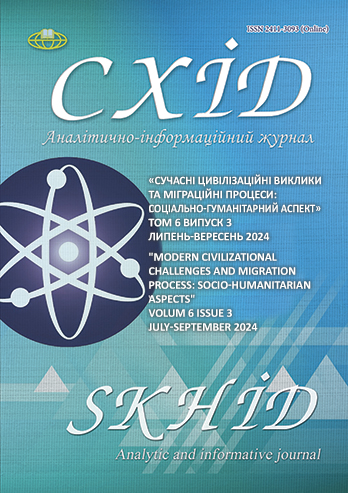Liminality in migration
DOI:
https://doi.org/10.21847/2411-3093.632Keywords:
migration, liminality, migration processes, emigrant, immigrant, refugee, identity, dual identityAbstract
The article addresses the issues of population migration, both planned and systematic, as well as uncontrolled and illegal, which have become an integral part of the existence of a globalized world. These processes serve as a vivid example of the blurring of borders and demonstrate the deepening interdependence of various factors and regions in the socio-economic, political, and cultural-spiritual spheres. Understanding migration processes, as multidirectional movements within the socio-cultural space of individuals and communities, driven by both objective and subjective reasons, is particularly important for Ukraine during the war with Russia, which has led to the displacement of numerous internally displaced persons, as well as the migration of millions of women and children beyond Ukraine's borders. The concept of liminality, especially in migration, is explained, explored, and philosophically substantiated, and how it influences migration processes in general, acculturation, and the adaptation of emigrants to foreign environments. It explores how this concept affects migration processes in general, acculturation, and the adaptation of emigrants to a foreign environment. The study looks into changes in micro- and macro-societies, the cultural environment of emigrants, and presents the author's concept of acquiring dual identity as one of the positive outcomes of the liminal state of emigrants. This concept suggests that quality integration into a foreign space can be achieved while preserving one's own national identity and gaining a new status as an immigrant. The article shows how the concept of "dual identity" helps emigrants or refugees overcome the liminal period during their integration into a foreign society.
Downloads
References
Bauman, Zygmunt (2000). Liquid modernity. Polity, Cambridge.
Bourdieu, Pierre (1977). Outline of a theory of practice. Cambridge, U.K.: Cambridge University Press.
Kolinko, M. (2022). Migrants as a resource of the precariat. Skhid, 3 (2), 76-81. https://doi.org/-10.21847/1728-9343.2022.3(2).287361
Frankl, V. E. (1959). Man’s Search for Meaning. An Introduction to Logotherapy (4th ed.). Beacon Press.
Freud, S. (1990). Five lectures on psycho-analysis. The Standard: W. W. Norton & Company. 112 р.
Jaspers, K. (1984). Der Philosophische Glaube an-gesichts der Offen-berung. München ; Zürich : R. Pieper & Co Verlag. (In German)
Park, R. E. (1928). Human migration and the marginal man. American Journal of Sociology, 33 (6), 881-893. https://www.journals.uchicago.edu/doi/epdf/10.1086/-214592
Scheler, M. (1973). Formalism in Ethics and Non-Formal Ethics of Values. Evanston: Northwestern University Press.
Terner, V. (1975). Revelation and Divination in Ndembu Ritual, Ithaca: Cornell University Press., p.31-32.
Van Gennep, A. (1934). Contribution a la methodology du folklore. Lares. Anno V, Marzo XII. Р. 20–34.
Downloads
Published
How to Cite
Issue
Section
License
Copyright (c) 2024 Оксана Терещенко

This work is licensed under a Creative Commons Attribution-NonCommercial-NoDerivatives 4.0 International License.
1. Authors bear responsibility for the accuracy of facts, quotations, numbers and names used.
2. Manuscripts are not sent back.
3. The publisher does not always agree with the authors' opinion.
4. The authors reserve the right to authorship of the work and pass the first publication right of this work to the journal under the terms of a Creative Commons Attribution-NonCommercial-NoDerivatives 4.0 International License. This license allows others to distribute (copy) the published work for non-commercial purposes, provided there is mandatory attribution to its authors and a link to the first publication in our journal.
5. The authors have the right to conclude separate supplement agreements that relate to non-exclusive work distribution in the form in which it has been published by the journal (for example, to upload the work to the online storage of the journal or publish it as part of a monograph), provided that the reference to the first publication of the work in this journal is included.

